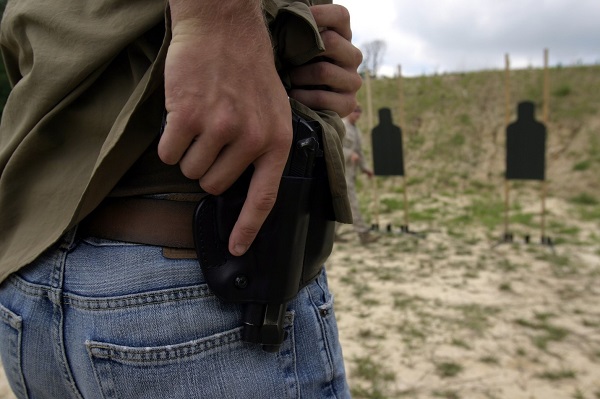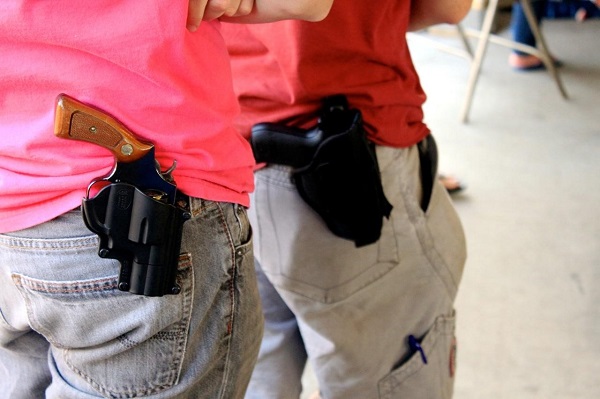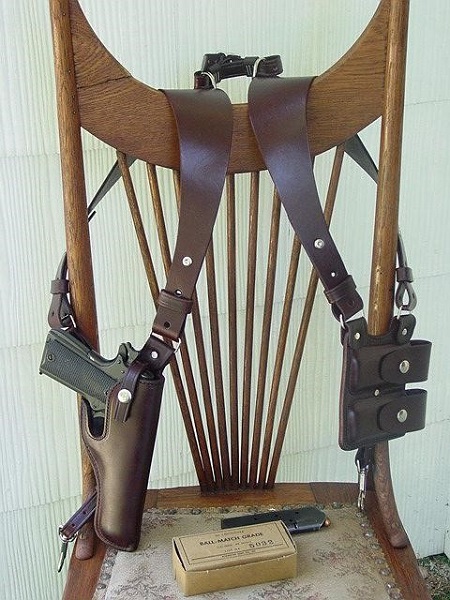
Unless you plan on every handgun you buy being a safe queen, you’ll want to find a quality holster that allows you to use it in comfort and safety. Handgun holsters come in a wide array of styles and can be made from several different materials. With so many options available, it can be hard to choose the best one for you. By better understanding the available holster styles, you can be more confident you’re choosing the right one. Read on here for a basic guide to buying your first holster.
Materials
Most holsters are made of leather, Kydex, or nylon. Some holsters, called hybrid holsters, combine two or more of these materials. The style of holster you decide on can have a bearing on what kind of material is used as each has its own benefits and limitations. Conversely, if you prefer a certain material over others, that could limit the styles available. Let’s take a close look at each material:
Leather
Leather is the most traditional holster material. It has proven durable and effective over the centuries for holding weapons securely. Leather holsters can be extremely comfortable, but if not cared for properly, can lose their shape or become scuffed and damaged.
Ballistic Nylon
Ballistic nylon is lightweight, fairly stiff, and offers good protection mixed with breathability. This material is used often in popular budget holsters, but don’t let that fool you. Nylon is a good, versatile choice for many carry situations.
Kydex
Kydex is a thermos plastic made by Sekisui SPI. It’s extremely lightweight, durable, and easily molded by manufacturers to fit a specific firearm. In many ways, this material revolutionized holster production. The downside is that the plastics are not breathable, and some cheaper holsters can cause increased wear to your gun’s finish at rub points, usually around the trigger guard and muzzle.
Hybrid
Technically, hybrid holsters can use of a combination of any of the above materials. The most popular, however, are made with leather and Kydex. This allows you to have the molded security and lighter weight of Kydex, backed with leather for greater carrying comfort.
Choosing The Right Style
When selecting the best style of handgun holster, it’s important to consider how you intend to carry your weapon. That will guide you toward a set of styles you can further narrow down based on your body shape, personal preference, or ease of use. If possible, try on the holster prior to purchase or, borrow a similar holster from a friend to see just how well it fits you in real life.
Open Carry

While there is sure to be an article of clothing that can cover any holster, some are designed for use primarily as open carry rigs.
Drop Leg
The drop leg holster is a familiar style to tactical shooting enthusiasts. This holster is suspended from your belt and secured to your thigh by straps, and is sometimes referred to as a thigh holster. This positions your weapon for a more natural draw from a relaxed position, but makes the holster more difficult, if not impossible, to conceal.
Outside Waist Band (OWB)
Outside the waistband holsters are exactly what they sound like: holsters that clip outside the waistband of your trousers or have a loop your belt runs through. They come in a wide range of styles and materials. While these can be used for concealed carry under a bulky outer layer, they tend to hold the gun looser against your side, making other holster options far superior for the purpose.
Paddle Back
These holsters are a variant of the OWB holster that relies on a large paddle shaped piece of the holster rather than a clip or belt loop. Popular due to the speed with which it can be donned and removed, the paddle slips inside your pants, leaving the bulk of the holster and your weapon comfortably on your hip. It otherwise functions the same as other OWB holsters.
Concealed Carry

Concealed carry holsters are designed to help hide the fact you carry a handgun. They may be mandated by law for carry in your location, but even in open carry states, some people choose to obtain the documentation necessary to carry concealed. Make sure you understand your jurisdiction’s laws before you start your holster search.
When selecting a holster for concealed carry, consider your body style and the clothing you typically plan to wear. The majority of concealed carry holsters are hidden easily under a coat, jacket, or long sweatshirt, while others require far less. Make sure you choose a holster that will allow you to carry 2½ pounds of metal under your clothing comfortably year round.
Pancake
The pancake holster is one of the best looking concealed carry choices. While it is technically an OWB holster that is worn on the belt, its design keeps your weapon close to your body where it rides high on your hip, so it’s concealed easier.
Inside Waistband (IWB)
IWB holsters clip to your waistband, but ride inside your pants. An IWB concealed leather holster is great for concealed carry, although you will have to wear pants that both fit around the waist snugly and provide room below the waistband to help conceal the weapon’s silhouette.
Combo
The combo holster is a variation of the IWB holster that allows you to change the clip’s position, so it can function as an OWB holster as well. This can be a good option if you wear a variety of different clothing styles that may suit one method over another — or in states that allow both concealed and open carry.
Horizontal Shoulder
Popular with movie secret agents everywhere, the shoulder holster hides your gun in your off-side arm pit. It allows for you to draw across your body. If you get your clothes tailored, request additional room through the back and shoulders of your jacket and it will work well under a suit.
Ankle
Ankle carry is popular among law enforcement as a carry position for a backup weapon. The ankle is fairly accessible, and few people watch your feet, so the likelihood of it being noticed is low. This is also a great carry style for to and from the gym, as it is well-hidden by sweatpants.
Other Holster Options
There are a few other features of holsters you need to be aware of that aren’t directly tied to their manufacture material or style of carry. Keep an eye out for these options:
Magazine or Speedloader Pouches
Some holsters will have a pouch for an additional magazine for your pistol or a speedloader for your revolver. If your favorite holster doesn’t offer this option, they are also available as standalone carriers in a similar style to most carry rigs.
Weapon Securement
Some holsters will have a feature meant to secure your weapon in the holster to prevent accidental drops and make it harder for your weapon to be taken away from you. While some use a tightly molded form to grip the weapon, especially the trigger guard, others will use a strap or a thumb break to keep you weapon secure.
Breaking In Your New Holster
When you buy a new holster, it’s not uncommon for it to be extremely rigid. While some choose chemicals (or in the case of Kydex, heat) to condition their holster, the easiest way to loosen it slightly and start the breaking in process is to place your handgun in a shopping bag, such as the plastic ones used by larger national retailers, and holster the firearm overnight.
To continue the process, you should to train with it. Under stressful situations, you will react the way you train. That means using the same rig at the range as what you plan to carry. Drawing and holstering your weapon repeatedly will not only help the holster give you a smooth, consistent draw, it will help you develop one too. It also helps your form muscle memory that will serve you well in case you need to use your weapon.
Informed Choices Are Smart Choices
By understanding the design intent and materials that go into holster production, you are better able to choose the best holster for your carrying needs. Make sure to evaluate yourself openly and honestly, and you will be able to find the right fit for your range rig or everyday carry.
Author Bio:
Brian Claywell is a freelance writer and blogger based in Austin, Texas. With a love for hunting, hiking, and the great outdoors in general, he spends much of his time writing outside. In his free time, he enjoys spending time at the shooting range.
Leave a Reply